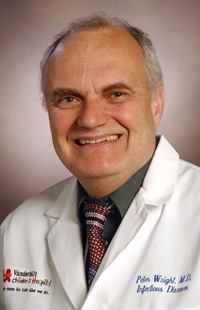
Peter Wright, M.D.
Researchers closing in on a RSV vaccine
A new study may bring researchers a step closer to developing the long-awaited vaccine for respiratory syncytial virus (RSV), the most common cause of respiratory illness in infants and young children.
In the Feb. 15 edition of The Journal of Infectious Diseases, VUMC’s Peter F. Wright, M.D., and colleagues identify a viral protein, NS2, as an important virulence factor for RSV and as a possible target for vaccine development.
In the United States, RSV is responsible for 18,000 to 75,000 hospitalizations and 90 to 1,900 deaths annually, according to the World Health Organization. Premature infants and children with heart or lung conditions or immunodeficiency are at the highest risk of developing RSV illness, but even healthy children can develop serious illness. RSV is also increasingly recognized as a cause of flu-like illness in the elderly, so a vaccine that can prevent RSV-associated illness is a priority.
The long road to an RSV vaccine began in the 1960s, but has yet to produce an FDA-approved vaccine. Some early vaccine candidates contained inactivated virus, similar to flu vaccines. However, these vaccines actually caused enhanced illness, suggesting RSV inactivated by 'traditional' methods was not safe.
RSV vaccine development stalled for many years, until renewed exploration of live, intranasal vaccines was begun by James Crowe, M.D., while at the National Institutes of Health. Also, the advent of new genetic technologies allowed researchers to manipulate the viral genome by deleting entire genes or making small mutations in genes important to the virulence of the virus. Currently, the focus is on using these genetic techniques to introduce defined mutations into specific RSV genes to make “designer” vaccine candidates. This may provide a better way of “attenuating” or weakening the virus so that it cannot cause illness.
“It's a slow process, certainly,” said Wright, now chief of Vanderbilt's Division of Pediatric Infectious Diseases, who has been involved with RSV vaccine development and testing since the 1960s.
“The technique we've been approaching is a live, attenuated vaccine, which is the most likely to produce immunity or protection. The protection probably won't be complete, but we hope to prevent hospitalization due to severe disease.”
Wright and colleagues' approach was to target viral genes that block the host's immune response.
Many viruses produce proteins that turn off aspects of the host's immune response. RSV's nonstructural proteins, NS1 and NS2, block the ability of the host cells to make interferon, an immune system protein that inhibits the growth of virus in the host cell.
“In doing that, they limit the cell's capacity to mount this first line of defense,” Wright said.
In the current study, Wright and colleagues deleted the gene for the nonessential accessory protein NS2 from three different RSV strains that had been tested previously. These new vaccine candidates were tested in adults and children.
The researchers found that deletion of the NS2 gene safely attenuated RSV in all age groups tested. However, at the doses tested, the vaccines did not induce an acceptable immune response. The gene deletion does seem to stabilize the virus, keeping it from reverting to its more infectious nature.
The three vaccines tested were “not necessarily the next best vaccine candidates,” Wright said. “But we have identified a whole new way of attenuating viruses by knocking out the genes that normally knock out host defenses like interferon.”
Also, since many viruses have such genes, this type of attenuation may be useful in vaccines against other viral infections.
“We've got the tools in hand now (genetic manipulation),” Wright said. “I think we're on the verge of a successful period of research leading to an RSV vaccine. I think the deletion of genes like NS2 is will be a component of future vaccines because it's a very powerful way of attenuating or weakening the virus.”
It is one more step in what has been a long and difficult process. Of the 10 or 12 vaccine candidates that have gone into clinical trials in children, only two have progressed to testing in infants.
“From each of them we've learned something,” Wright said.
Likening the process to the Goldilocks sampling of the Three Bears porridge, “one is a little too hot, one is a little too cold,” he said. “We think there is something that is just right.”













